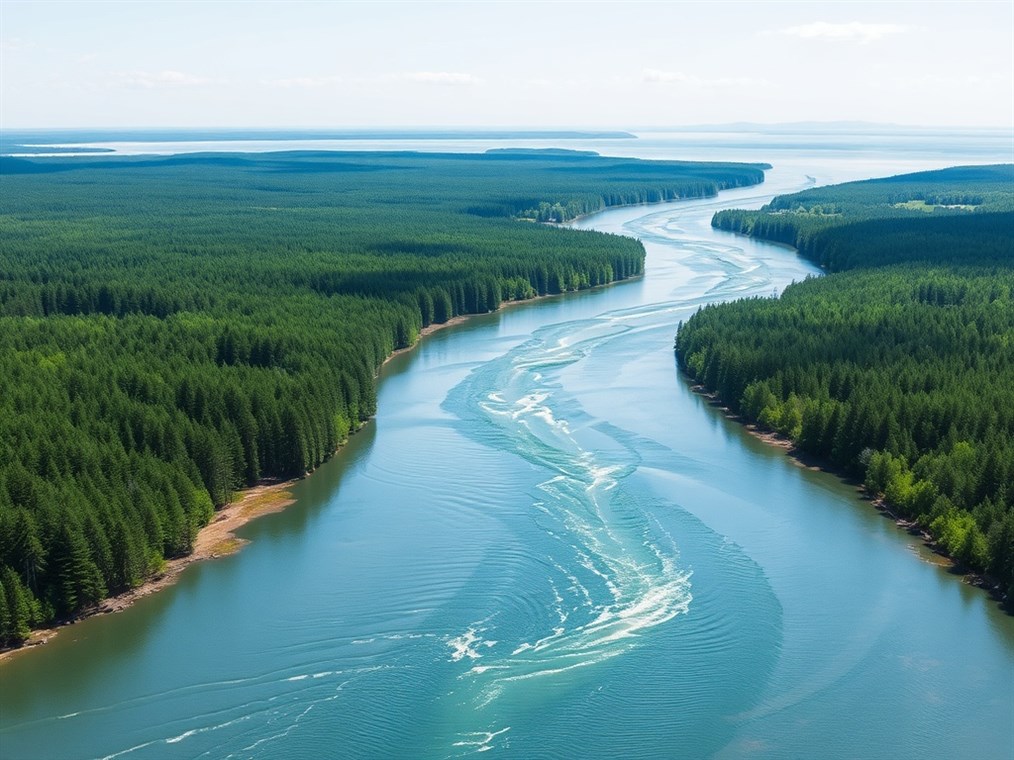
The St. Lawrence River: A River’s Journey to the Sea
FactsThe St. Lawrence River: A River’s Journey to the Sea
Ever wonder where all that water from the Great Lakes ends up? Well, it’s quite a journey, really. It all flows into the St. Lawrence River, a major player in North America’s waterways. This isn’t just some stream; we’re talking about a massive hydrographic system, including the Great Lakes themselves! From its furthest source to where it finally meets the ocean, it stretches almost 1,900 miles. But the real question is: where does this incredible river actually go?
Let’s start at the beginning. The St. Lawrence kicks off its adventure at the point where Lake Ontario pours out its waters. From there, it heads northeast, cruising past cities like Cape Vincent, Gananoque, Montreal, and Quebec City. Think of it as a scenic road trip for water! Up to this point, it’s all freshwater, and the tides don’t affect it.
Now, things get interesting. As the river flows past Quebec City, it starts to spread out and transform into something special: an estuary. And not just any estuary – the St. Lawrence Estuary is one of the biggest in the world! You can picture it starting just east of Île d’Orléans, a little downstream from Quebec City. That’s where the river starts feeling the pull of the tides.
This estuary is seriously huge, stretching over 400 miles from west to east, from Lake Saint Pierre all the way to Pointe-des-Monts. That’s where it merges into the Gulf of St. Lawrence. Here, the freshwater from the river starts mixing it up with the saltwater coming in from the Atlantic. It’s like the river’s saying “Hello ocean!”
The estuary is divided into three distinct sections:
- First, you have the Fluvial Estuary, a freshwater zone running from Lac Saint-Pierre to the eastern tip of Île d’Orléans. Even though it’s freshwater, the tides still have an impact here.
- Next up is the Upper Estuary, also known as the brackish zone. This is where the real mixing happens, from Île d’Orléans to where the Saguenay River joins the St. Lawrence.
- Finally, there’s the Lower Estuary, stretching from Tadoussac to Pointe-des-Monts.
So, where does all this lead? Ultimately, the St. Lawrence River flows into the Gulf of St. Lawrence, a massive body of water that’s basically an arm of the Atlantic Ocean. The Gulf is bordered by the North Shore, the Gaspé Peninsula, and Anticosti Island. From there, the waters flow freely into the vast Atlantic.
The St. Lawrence River system, when you include the Great Lakes, is truly a hydrographic giant. It’s one of the largest systems of its kind on the planet! Its drainage basin covers a huge chunk of land in both Canada and the United States. In fact, it drains over 25% of the world’s freshwater reserves. That’s a lot of water! The Great Lakes-St. Lawrence River Basin is the world’s largest watershed, holding over 20% of the world’s surface fresh water and about 84% of North America’s surface fresh water.
From its humble beginnings at Lake Ontario to its grand finale in the Atlantic Ocean, the St. Lawrence River is a testament to the power and beauty of nature. It’s a vital waterway that shapes the geography and economy of North America. It’s more than just a river; it’s a lifeline.
You may also like
Disclaimer
Categories
- Climate & Climate Zones
- Data & Analysis
- Earth Science
- Energy & Resources
- Facts
- General Knowledge & Education
- Geology & Landform
- Hiking & Activities
- Historical Aspects
- Human Impact
- Modeling & Prediction
- Natural Environments
- Outdoor Gear
- Polar & Ice Regions
- Regional Specifics
- Review
- Safety & Hazards
- Software & Programming
- Space & Navigation
- Storage
- Water Bodies
- Weather & Forecasts
- Wildlife & Biology
New Posts
- Diving Deep into Tangerine: More Than Just a Sunny Locale
- Jamaica Backpack Daypack Pockets Shopping – Review
- TEOYETTSF Climbing Backpack Multifunction Military – Buying Guide
- The Curious Case of Cavendish’s Classroom: Where Did This Science Star Study?
- Dragon Backpack Insulated Shoulder Daypack – Buying Guide
- ROCKY Hi-Wire Western Boots: A Rugged Review After a Month on the Ranch
- Vertical Curbs: More Than Just Concrete Barriers
- Regatta Modern Mens Amble Boots – Honest Review
- YMGSCC Microfiber Leather Sandals: Beach to Boardwalk, Did They Hold Up?
- Tangier: More Than Just a Backdrop in “Tangerine”
- DJUETRUI Water Shoes: Dive In or Doggy Paddle? A Hands-On Review
- Barefoot Yellow Pattern Hiking 12women – Is It Worth Buying?
- Koa Trees: How Fast Do These Hawaiian Giants Really Grow?
- DDTKLSNV Bucket Hat: Is This Packable Sun Shield Worth the Hype?